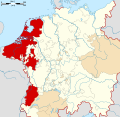
The Nijmegen Quarter (Dutch: Kwartier van Nijmegen) was the first of the four quarters in which the county, later Duchy of Guelders was divided, as they were separated by rivers. In addition Guelders consisted of Zutphen Quarter, the Upper Quarter and Veluwe Quarter. [1] Each quarter had its own capital.
